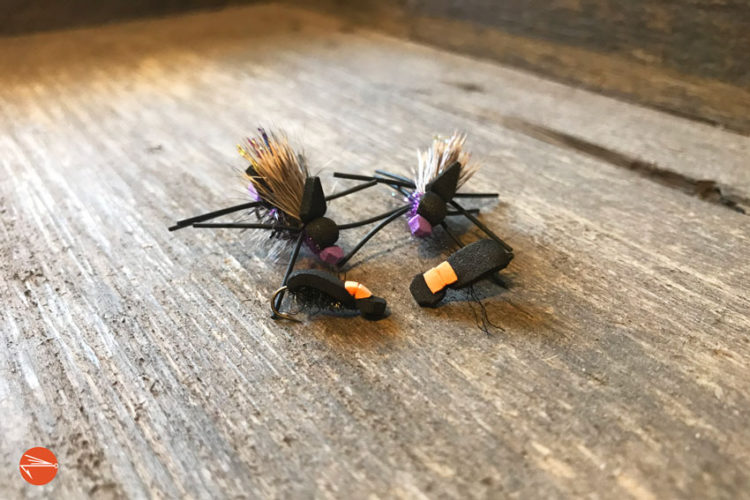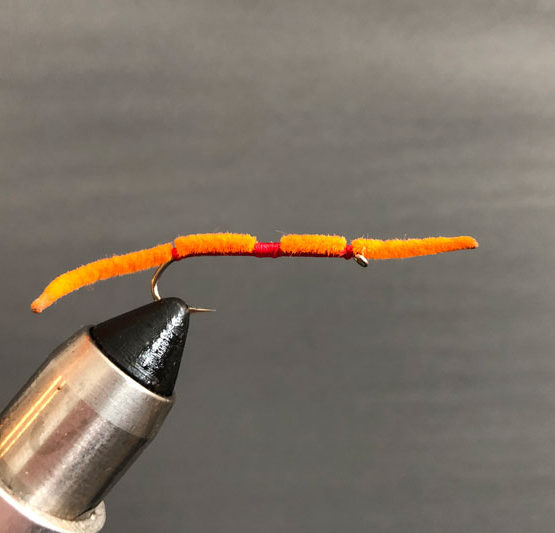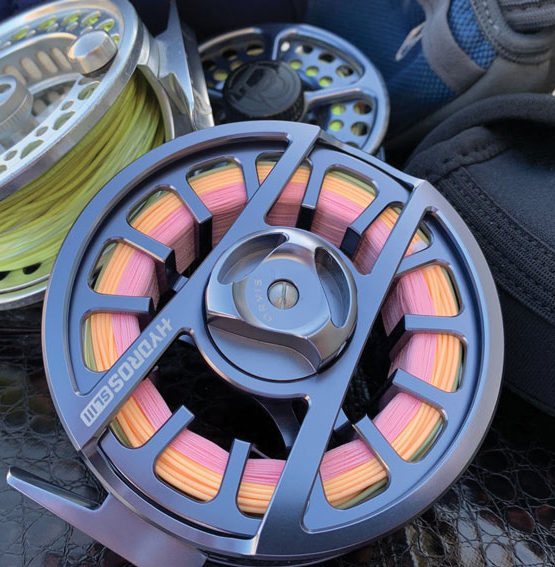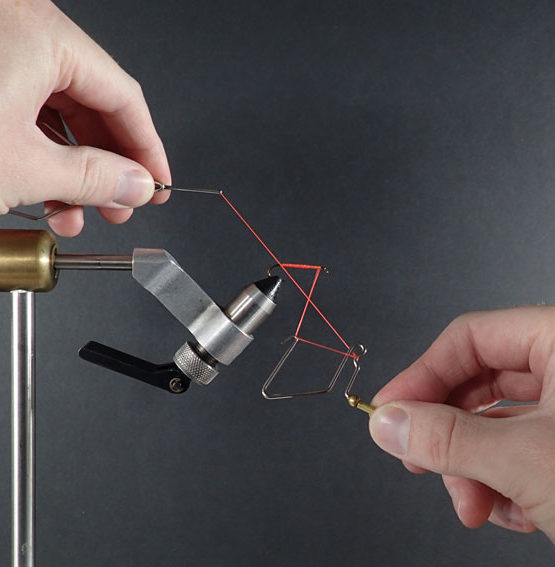Looking to fill your fly box with a killer selection of foam flies? In this post, I reveal 12 of the absolute best (and proven) foam fly patterns.
So, find your favorite easy chair and grab a fluffy pillow… and then start cutting them both up to get at the giant amounts of foam you’ll need to tie some of these beefcakes.
Or if, like me, you’d rather someone else do the heavy assembly work while you just browse and buy, then ditch the recliner and pillow, get online, or out to your favorite fly shop and lock down a hearty selection of Fly Fishing Fix’s top foam fly recommendations.
Let’s dive in!
Disclaimer: This post may contain affiliate links, meaning we will receive a small commission (at no cost to you) if you click through and make a purchase.1. Foam Ant
Maybe you haven’t quite picked up on this nuance yet, but it oughta be clear from the preamble above that foam flies tend to run big. We’ll get to the big guys in a few, but let’s start on the small side with the Foam Ant.
Usually available in a hi-vis format with a brightly colored dot on it’s back, a standard Foam Ant’s silhouette looks just like the real thing to a prowling trout that happens to be gazing skyward. I’ve enjoyed some of my most exciting dry fly moments right after tying on a black Foam Ant and slapping it diagonally toward a dark cut bank on a meandering meadow’s stream. If an afternoon wind kicks up, it won’t be long before I’ve gone to the Foam Ant (or Flying Foam Ant) in either black or cinnamon. In my experience, trout don’t sip ants; they attack them.
Big things certainly do come in small packages.
2. Foam Beetle
Along the same lines as the Foam Ant, the Foam Beetle is known to produce electric, slump-busting strikes.
Since clumsier beetles are known to fall into the river without necessarily being blown into it, try dropping a Foam Beetle in off the bank, that is, if you can do so without too much snag potential. Then, let it drift over a deep run with a high-stick and a little twitch, and see if it doesn’t bring Jaws up from below. Since it probably will, the authorities will be forced to close the nearby beetle beaches to summer water recreation.
3. Foam Hopper
Of course, no foam fly discussion can really even get started without the inclusion of the Foam Hopper.
With its bronze bust certainly enshrined in the front rotunda of the Traditional Foam Hopper Hall of Fame, Dave’s Foam Hopper gets our nod as the most legendary and iconic among the cornucopia of Foam Hopper patterns.
Some have advanced the idea that Dave’s Foam Hopper got into The Hall on the wings of his non-foam predecessor, but a foam fly box is definitely not complete without a row of Dave’s.
And when these babies hit the water on a hot and breezy summer afternoon, they bob up and down like a cork. This action usually provides enough natural twitch and faux grasshopper leg movement that you won’t need to add any rod tip enhancements.
By the way, as with most of the flies on this list, Foam Hoppers make terrific hopper-dropper platforms. But I bet I didn’t even need to write that.
4. Foam Cricket
Sticking with the more traditional group, or foam flies that closely mimic things actually found in nature, the standard Foam Cricket looks so realistic that I once tried to spray one that had fallen from my vest to the garage floor with Raid.
I wish I was kidding about that.
Later, I could have sworn I saw the real garage cricket — the one that had been keeping me awake for two weeks — flip the fake one a fiver to thank him for adding to my torment.
Keep three or four Foam Crickets in your box and don’t be afraid to splash them in with an ugly hopper-style cast. If you have trouble seeing black flies on the water, stock the hi-vis variety, however, when a trout annihilates a Foam Cricket, I promise, you won’t have aaannny trouble seeing it.
Related Posts:
- 15 Best Flies For Cheesman Canyon
- 15 Best Nymphs For Colorado (Here’s What You Need)
- 21 Best Flies For The Bighorn River
- 10 Baetis Nymph Patterns You Need To Try
- 7 Best Strike Indicators For Fly Fishing
5. Neversink Caddis
I have accumulated so many traditional Caddis imitations over the years that I should just give in and commit an entire box to Caddis adults, larva, pupa and maybe a few nice Caddis-shuck jewelry pieces. If I do so, I’ll commit a whole section to the Neversink Caddis, a foam fly that pretty much solves the problem of too-quick-to-sink Elk Hair Caddis patterns.
The Neversink’s foam chassis means that it rides high, is easy to identify in a Caddis hatch blizzard, serves as a great lead fly for a sexy dry-dropper rig and, well, never sinks! The Neversink comes in a variety of hue combinations and sizes, but color me sold on this great foam fly.
6. Foam Mayfly Drake
If you’re blessed to encounter a full drake hatch, let me first say, congratulations! Depending upon how often and where you do most of your fly fishing, a drake hatch can be a rather elusive event. But it’s one that should be treated with awe, respect and… pant-wetting excitement!
Because they can be rare and short-lived, if you find yourself in the midst of one, you may not want to waste time, between strikes and nettings, painstakingly redressing your traditional drake imitations. For this reason, keeping a few Foam Mayfly Drakes in your fly box is a good idea. Foam flies do need to be dressed, just nowhere near as often and as thoroughly, which means that, during that epic drake hatch, you’ll spend more time casting and catching and less time dabbing, dressing and drying. Drake ‘n bake, Ricky Bobby!
7. Amy’s Ant
Without a doubt, the most inaccurately named foam fly of the bunch, if I ever encounter an actual ant that looks anything like an Amy’s Ant, I might need to make sure I haven’t breached the boundaries of Area 51. I hear the feds get a little touchy about that.
Available in several color combinations, Amy’s Ants look like a jackrabbit that just pounced on a sparkly popsicle. Add a few rubbery legs along each side, and this foam terrestrial gives new meaning to the word hodgepodge. But is it effective? Oh yeah!
Is it an ant? Heck no! Is it a hopper? Maybe. Is it an alien being sent to suck out my brains? Who cares. In the right situation, Amy’s Ants are deadly, and if trout are open to an Amy’s Ant offering, my brains are expendable.
Needless to say, we highly recommend you stock a few Amy’s Ants. Just know that we can’t claim responsibility if one mysteriously winds up on your pillow, staring you in the face upon awakening some crazy summer morning.
8. Eric’s Clodhopper
If you sense that we’ve stumbled into the Ripley’s Believe It Or Not section of the fly shop, you’re not mistaken. Hang on. It only gets weirder.
Similar to the Amy’s Ant in general appearance, this foam terrestrial could double as one of those classic ice cream sandwiches we all love, that is, if you don’t mind that your ice cream sandwich has sprouted a tuft of gnarly white fuzz and six black-and-white striped legs. Yummy!
That said, in the world of foam flies, Eric’s Clodhopper has achieved legendary status in comparatively short order. When that happens, it’s an incredibly strong sign that a fly pattern performs. We’ll go ahead and vouch for it. It does.
9. Chubby Chernobyl
If Dr. Seuss tied flies, I’m pretty sure he would have come up with something akin to the Chubby Chernobyl. Tie a couple of slabs of foam together with two sections of what might actually be twine, add in couple blobs of white fuzz, a sparkly tail and four sets of pale rubber legs, and you’ll have yourself either a killer Chubby Chernobyl terrestrial or the beginnings of a bad acid flashback.
No one seems to know what trout actually see in this big bug, but attack it they do. Don’t question it. Just tie one on some warm and breezy summer afternoon, toss it out, and don’t be surprised if a fat trout hits it like a torpedo.
10. Cousin It
When a fly fisherman like me gets hot multiple times on a certain kind of fly, that fly is thenceforth, going to hold a special place in said angler’s heart. He or she will go to it time and time again, even if it’s not a hatch match.
Stoneflies hold such a place in my heart. I’ve enjoyed so many multi-fish episodes with stoneflies on my line that I get schoolgirl-giddy when I see signs of stones in or around the river I happen to be fishing. So, if you’re looking for a killer foam stonefly imitation, the Cousin It is your ticket to trout-netting success.
Now that I think about it, I believe they could have just called it the “It” because, when it comes to simple, effective, reliable and sturdy foam flies, the Cousin It is, well, IT. Buy IT. Stock IT. Fish IT. Love IT.
11. Foamulator
I don’t know an angler who doesn’t love when conditions encourage tying on a Stimulator. Colorful and easy to see, Stimulators possess an oddly powerful allure when an angler is studying his or her fly box to decide on the next money rig. Stimulators also have the uncanny ability to attract monster strikes from bedazzled trout. Despite their ability to command such attention, traditional Stimulators suffer from one primary drawback: they get soggy and sink too quickly.
The antidote? The Foamulator.
When tied with golden foam, they serve as a great stonefly imitation, however, like their traditional counterparts, they come in olive, orange and yellow too. And, since we’re talking about money rigs, a golden Foamulator lead with a Flashback Pheasant Tail or Red Copper John dropper ought to keep things interesting.
12. Fat Albert
When I was in elementary school, I carried a Fat Albert lunchbox. That little fact is in no way germane to the topic at hand; I just thought it best to confess the embarrassment. I feel better.
Another foam terrestrial pattern that looks like it just hopped out of Whoville, the Fat Albert is certainly more aptly named than its hillbilly cousin, the Amy’s Ant.
The Fat Albert’s most common composition features a black foam body, a red foam “backpack” and a white fuzz wing section. A few black rubber legs and antennae complete the picture. This pattern best mimics a cricket or cicada, but that trout react to it as if they’ve lost their minds should be the only thing you care about.
Fat Albert flies come in several color combinations, such as: orange and brown, pink and brown, black and purple, and others. Regardless of color, a few Fat Alberts will “round” out your foam fly selection ever so nicely.
You Might Also Like:
- How To Plan A Great Fly Fishing Trip (9 Simple Tips)
- What Are Forceps Used For In Fly Fishing?
- What Is The Best All-Around Fly Rod Weight?
- What Is A Large-Arbor Fly Reel? Plus 7 Key Advantages
- 21 Common Fly Fishing Mistakes To Avoid
- 25 Proven Tips To Catch More Trout
Final Thoughts
There it is! The Fly Fishing Fix Hall of Foam Fly Fame. How’s that for near-perfect alliteration, by the way? But I digress…
For those who have had the pleasure of experiencing it, there is nothing quite like spending a warm summer day, thigh-deep in a cool river, lake or pond casting foam flies and foam terrestrials to voracious trout.
As always, we Fly Fishing Fix pontificators invite contributions from our readers. What’s your favorite foam fly? When do you recommend using it? Are you willing to share your top secret foam fly dropper combinations with the class? We hope so.
On the other hand, if you just want to sit back, read, learn and empty your wallet on recommended fly fishing equipment, clothing, and flies, that’s cool too. Just be sure to sign up to get Fly Fishing Fix in your inbox, or you’re liable to miss out. That would suck, don’t you think?
Tight lines!










